Gerard Prent (born 25 December 1954 in Amsterdam) is a contemporary Dutch painter.
Contents


Gerard Prent (born 25 December 1954 in Amsterdam) is a contemporary Dutch painter.


Gerard Prent had his art education in Amsterdam at the Rietveld Academy (1973–1978) and the Rijksakademie (1978–1980). His first canvases utilized large, lively colored fields, often set in divergent frames. From the very beginning of his career, he has shown a preference for large, square formats for his paintings.
He was commissioned to create murals in the newly constructed government buildings in the Netherlands, such as the customs office in Vlissingen, the correctional facilities of Zwolle and Heerhugowaard, and the Dutch Ministry of Foreign Affairs in The Hague. [1] It was within these structures that his work developed in a more anecdotal and allegorical mode; while exploring various kinds of media, submerging the painting for the time being.
After an attempt to move away from art, the muse, after having nearly throttled him, took hold of him and has not let go. His attempt to live outside of art in France was the catalyst for his discovery of the joy of painting through the simplicity of his subject and the emphasis on the transparency of his palette. Add he was looking for study material in the Amsterdam Zoo (Artis), the sparrow forced itself upon him, as a free and everyday subject. The little bird ended up in the center of a square canvas, with the painter's experiment (or experience) happening in the large background of the painting. The sparrow continues unmoved by the surrounding landscape, becoming mythic in its serenity and through the use of reproduction.
Gerard Prent created a large series of “Mussen” (Sparrows in Dutch), of which many paintings found their way to collectors and admirers. The simplicity of the subject has remained: from 2004 onwards Prent continues to paint just a simple corner in the garden, or a spot on the side of the road, with large strokes and exuberant colours and shapes. According to Gerard Prent, it is not the subject that matters, but the image, the creation of pure art.
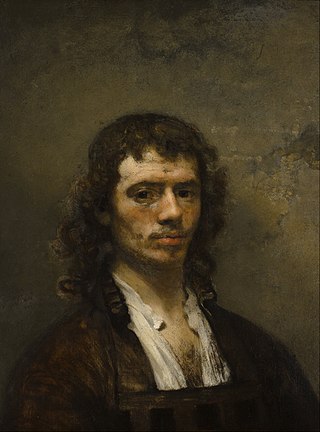
Carel Pietersz. Fabritius was a Dutch painter. He was a pupil of Rembrandt and worked in his studio in Amsterdam. Fabritius, who was a member of the Delft School, developed his own artistic style and experimented with perspective and lighting. Among his works are A View of Delft, The Goldfinch (1654), and The Sentry (1654).
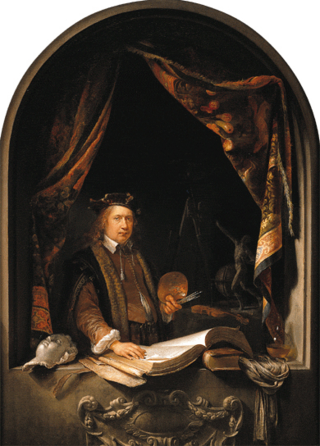
Gerrit Dou, also known as GerardDouw or Dow, was a Dutch Golden Age painter, whose small, highly polished paintings are typical of the Leiden fijnschilders. He specialised in genre scenes and is noted for his trompe-l'œil "niche" paintings and candlelit night-scenes with strong chiaroscuro. He was a student of Rembrandt.

Nicolaes Maes was a Dutch painter known for his genre scenes, portraits, religious compositions and the occasional still life. A pupil of Rembrandt in Amsterdam, he returned to work in his native city of Dordrecht for 20 years. In the latter part of his career he returned to Amsterdam where he became the leading portrait painter of his time. Maes contributed to the development of genre painting in the Netherlands and was the most prominent portrait painter working in Amsterdam in the final three decades of the 17th century.

Gerard ter Borch, also known as Gerard Terburg, was a Dutch genre painter who lived in the Dutch Golden Age. He influenced fellow Dutch painters Gabriel Metsu, Gerrit Dou, Eglon van der Neer and Johannes Vermeer. According to Arthur K. Wheelock Jr., Ter Borch "established a new framework for subject matter, taking people into the sanctum of the home", showing the figures' uncertainties and expertly hinting at their inner lives. His influence as a painter, however, was later surpassed by Vermeer.
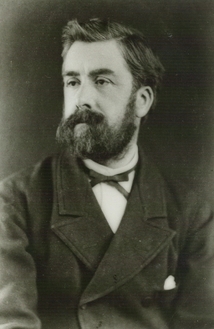
Anthonij "Anton" Rudolf Mauve was a Dutch realist painter who was a leading member of the Hague School. He signed his paintings 'A. Mauve' or with a monogrammed 'A.M.'. A master colorist, he was a very significant early influence on his cousin-in-law Vincent van Gogh.

Bartholomeus van der Helst was a Dutch painter. Considered to be one of the leading portrait painters of the Dutch Golden Age, his elegant portraits gained him the patronage of Amsterdam's elite as well as the Stadtholder's circle. Besides portraits, van der Helst painted a few genre pictures as well as some biblical scenes and mythological subjects.

Alex Katz is an American figurative artist known for his paintings, sculptures, and prints. Since 1951, Katz's work has been the subject of more than 200 solo exhibitions and nearly 500 group exhibitions throughout the United States and internationally. He is well known for his large paintings, whose bold simplicity and heightened colors are considered as precursors to Pop Art.

The Art of Painting, also known as The Allegory of Painting, or Painter in his Studio, is a 17th-century oil on canvas painting by Dutch painter Johannes Vermeer. It is owned by the Austrian Republic and is on display in the Kunsthistorisches Museum in Vienna.

Dutch Golden Age painting is the painting of the Dutch Golden Age, a period in Dutch history roughly spanning the 17th century, during and after the later part of the Eighty Years' War (1568–1648) for Dutch independence.

Rembrandt Harmenszoon van Rijn, usually simply known as Rembrandt, was a Dutch Golden Age painter, printmaker, and draughtsman. An innovative and prolific master in three media, he is generally considered one of the greatest visual artists in the history of art. It is estimated Rembrandt produced a total of about three hundred paintings, three hundred etchings, and two thousand drawings.
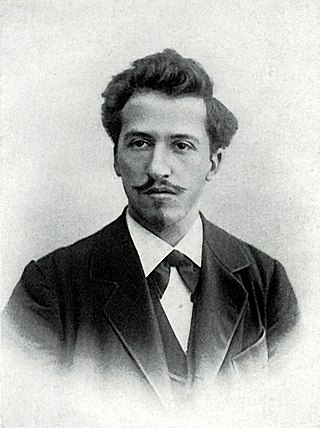
Pieter Cornelis Mondriaan, after 1906 known as Piet Mondrian, was a Dutch painter and art theoretician who is regarded as one of the greatest artists of the 20th century. He is known for being one of the pioneers of 20th-century abstract art, as he changed his artistic direction from figurative painting to an increasingly abstract style, until he reached a point where his artistic vocabulary was reduced to simple geometric elements.

Gerard or Gérard (de) Lairesse was a Dutch Golden Age painter and art theorist. His broad range of skills included music, poetry, and theatre. De Lairesse was influenced by the Perugian Cesare Ripa and French classicist painters such as Charles le Brun, Simon Vouet and authors such as Pierre Corneille and Jean Racine. His importance grew in the period following the death of Rembrandt. His treatises on painting and drawing, Grondlegginge Ter Teekenkonst (1701), based on geometry and Groot Schilderboek (1707), were highly influential on 18th-century painters.
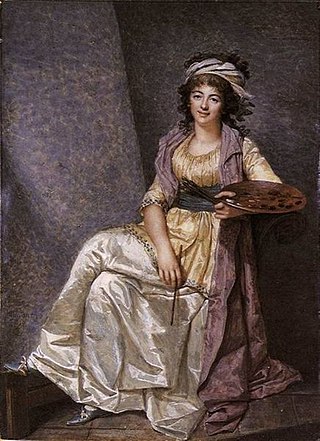
Marguerite Gérard was a French painter and printmaker working in the Rococo style. She was the daughter of Marie Gilette and perfumer Claude Gérard. At eight years old, she became the sister-in-law of Jean-Honoré Fragonard, and when she was 14, she went to live with him. She was also the aunt of the artist Alexandre-Évariste Fragonard. Gérard became Fragonard's pupil in the mid-1770s and studied painting, drawing and printmaking under his tutelage. Gérard and Fragonard created nine etchings in 1778. Historians currently believe Gérard was the sole artist of five of these etchings, since many have a duplicate created by her tutor Fragonard. More than 300 genre paintings, 80 portraits, and several miniatures have been documented to Gérard. One of her paintings, The Clemency of Napoleon, was purchased by Napoleon in 1808.

Carel van Savoyen or Carel van Savoy (1620/21–1665) was a Flemish painter, draughtsman and printmaker who was active in Antwerp and Amsterdam. He is mainly known for his history paintings and portraits but he also painted allegories and genre scenes.

Albertus Gerardus "Gerard" Bilders was a Dutch landscape-painter, associated with some members of the Hague School, as Anton Mauve and Willem Maris.

Johannes Warnardus Bilders was a Dutch landscape-painter; he was the father of Gerard Bilders (1838–1865) and a forerunner of the Hague School because of his connections with H.W. Mesdag, Jozef Israëls, Willem Roelofs, his later wife Marie Bilders-van Bosse and others painters of The Hague.

Guillaume Theodoor Lo-A-Njoe is a Dutch painter of Surinamese descent. He is married and has one son. He currently resides and works in Amsterdam where he celebrated his 60th anniversary as an artist in 2019.

Portrait of Jan Six is a 1654 oil-on-canvas painting by the Dutch painter Rembrandt van Rijn. Having been handed down many generations, via the direct descendants of the portrait's subject, Jan Six, the work remains in the Six Collection in Amsterdam.

Children Playing with a Goat is an 18th-century grisaille painting in the style of Jacob de Wit, known as a "witje". It is an oil painting on canvas depicting a relief of children playing with a goat after a relief by Francois Duquesnoy. It is in the collection of the Metropolitan Museum of Art.
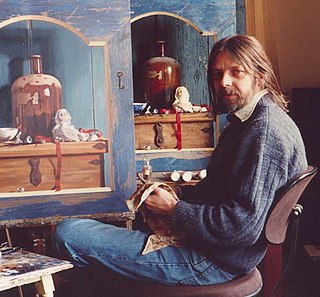
Rob Møhlmann is a Dutch artist, poet and writer of art books. He would predominantly manifest himself as a visual artist, but also wrote several articles, collections of poems, and dozens of books on art. In addition, he started his own museum "to house art that represents something", conceived and organized numerous exhibitions. He would also accumulate a large art collection.